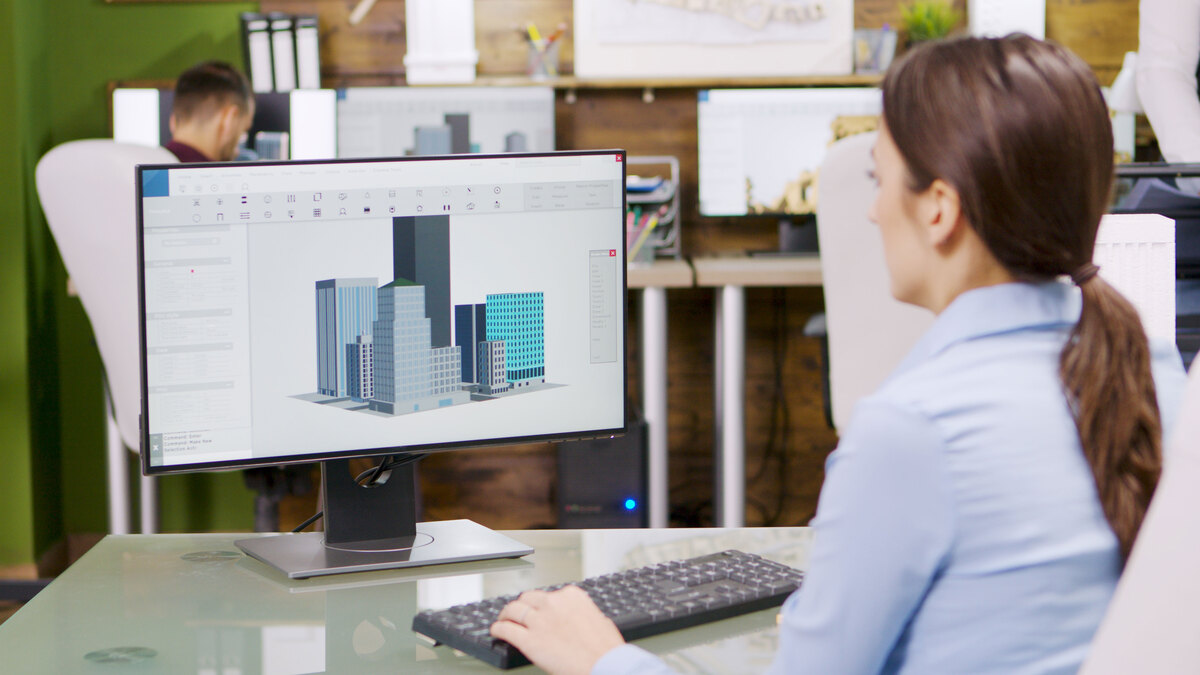Understanding the financial landscape of Scan to BIM services is integral to the contemporary construction industry specifically in 2024. Scan Building Information Modeling has revolutionized the way architectural and engineering projects are approached, offering a seamless transition from physical structures to comprehensive digital models.
The cost considerations involved in this transformative technology are multifaceted, encompassing various elements that directly impact the overall expenditure. Exploring the pricing structures of Scan to BIM delves into a complex interplay of factors, including the intricacy of the project, the extent of scanning required, software and technology utilization, skilled manpower, project timelines, and the desired level of detail and accuracy.
The aspect of Scan to BIM cost is not only influenced by the technological advancements and hardware requirements but also by the expertise needed for data processing, modeling, and implementation. This article explores the factors influencing Scan to BIM cost, highlighting the relationship between technology investment, project scope, and the value of integrating physical spaces into digital models. Understanding the various components that contribute to Scan to BIM cost is crucial for stakeholders navigating the terrain of modern construction methodologies and digital transformation within the industry.
Table of Contents
What is “Scan to BIM”?
Scan to BIM involves generating a digital model that mirrors the current state of a building, encompassing its physical and operational features within a BIM framework. Using specialized laser scanning technology, precise 3D scans are obtained and integrated into BIM software such as Autodesk’s Revit, Graphisoft’s ArchiCAD, Vectorworks, and others. This process allows for the creation of precise representations of existing structures or the incorporation of design elements into real-world contexts.
How Scan to BIM Works
The process of scan to BIM converts the visual and spatial aspects of a building or site into an easily understandable model packed with actionable information within a few hours. This technology is poised to replace several traditional construction tools, including basic tools like tape measure. Scan to BIM resembles 3D photogrammetry and, depending on how the 3D model is interacted with, has ties to augmented reality (AR).
The workflow of scan to BIM starts with a laser scanner, which can be attached to an aerial drone, mounted on a stationary tripod, carried around a site, or worn by an individual. This scanner captures spatial points that correspond to the site’s geometry—such as walls, doors, ground surfaces, openings, and more—tracking the position of each point along its x, y, and z axes.
The resulting point cloud contains vast amounts of data. Certain scanners can capture 2 million unique points per second and accumulate 600 million points within a five-minute scan. The scanner determines the position of these points by emitting a light beam and measuring the time it takes to bounce back. Lidar (Light Detection and Ranging) is the primary scanning method, although some scanners utilize SLAM (Simultaneous Localization and Mapping) algorithms, which can identify the scanner’s location while assembling the point-cloud map.

Benefits of Scan to BIM
Scan to BIM brings a multitude of advantages to stakeholders in the AEC sector, especially in projects involving renovation, conservation, or retrofitting, where a thorough grasp of existing structures is essential. These benefits encompass:
- Heightened Accuracy: Scan to BIM offers precise and detailed information about current conditions, significantly reducing errors in design and construction phases.
- Increased Efficiency: Creating digital twins of existing buildings streamlines design, eliminating the need for manual measurements and allowing focus on design and problem-solving.
- Informed Decision-Making: The multi-dimensional data from Scan to BIM grants stakeholders a deep understanding of sites or buildings, aiding informed decision-making and preemptively addressing issues in the virtual realm before construction.
- Preserving Historic Structures: In conservation projects, Scan to BIM digitally captures and preserves intricate details of historical structures, guiding sensitive and appropriate restoration and renovation strategies.
Significance of Scan to BIM in the Construction Industry
Scan to BIM is a game-changer in the construction industry, reshaping how projects are conceived, designed, and executed. Its significance is multifaceted, fundamentally altering the way stakeholders interact with building information.
Firstly, Scan to BIM bridges the gap between physical reality and digital representation. By employing cutting-edge scanning technologies like Lidar, it captures highly accurate 3D data of existing structures swiftly and comprehensively. This precision minimizes errors, mitigates risks, and enhances the overall quality of project documentation and planning.
Secondly, this technology fosters unparalleled efficiency. Traditional methods involving manual measurements are time-consuming and prone to inaccuracies. Scan to BIM eradicates this reliance on manual data collection, allowing for the creation of detailed digital models. Consequently, architects and engineers can focus on design intricacies and problem-solving, accelerating project timelines and reducing costs.
Moreover, Scan to BIM’s impact extends beyond the construction phase. It serves as a repository of comprehensive, multi-dimensional data, empowering stakeholders with in-depth insights for informed decision-making. The ability to visualize and analyze the virtual model aids in identifying potential clashes, conflicts, or structural issues before physical construction commences, significantly reducing rework and change orders.
Additionally, Scan to BIM plays a crucial role in heritage preservation. For conservation projects involving historical buildings, it offers a non-intrusive means to capture intricate details, facilitating sensitive restoration and preservation efforts.
Ultimately, Scan to BIM is more than a technological advancement; it’s a paradigm shift. Its significance lies in its ability to enhance precision, streamline processes, enable informed decisions, and contribute to the preservation of architectural heritage, revolutionizing the construction industry’s approach to project management and execution.

Factors that Affect Scan-to-BIM Costs
The Scan to BIM costs projects can be influenced by several key factors, each playing a significant role in determining the overall expenses involved in this process.
1. Project Scope and Complexity
The project’s magnitude and intricacy play a pivotal role in determining expenses. Larger projects typically necessitate broader scanning, data processing, and modeling efforts, which result in higher costs. Moreover, intricate designs or structures require more precise scans and careful modeling, intensifying the overall expenses.
2. Technological Requirements and Equipment
The choice of scanning technology and equipment significantly affects costs. High-precision laser scanners or specialized equipment provide more accurate scans but might come with higher operational costs. Similarly, the utilization of advanced BIM software incurs licensing fees and necessitates skilled personnel for data processing and model creation, contributing to higher expenses.
3. Data Processing and Modeling Complexity
Handling various types of data such as point clouds, photographs, and other inputs necessitates sophisticated processing and integration into a cohesive BIM model. The complexity and scale of the data involved influence the labor-intensive nature of data processing and modeling, thereby impacting costs.
4. Expertise and Labor Costs
Skilled professionals capable of interpreting scans accurately and creating detailed BIM models are essential for the success of the project. The expertise and experience of personnel directly affect project timelines and the level of detail in the final model, consequently impacting costs.
5. Project Location and Accessibility
The geographic location and accessibility of the project site can affect costs. Remote or challenging-to-access sites may require additional logistical planning, specialized equipment, or increased travel time for personnel, leading to higher expenses.
6. Regulatory Compliance and Standards
Compliance with specific industry standards and regulations adds complexity to the modeling process and impacts costs. Ensuring that the BIM models adhere to safety, quality, and regulatory standards requires additional effort and expertise, contributing to expenses.
7. Client Requirements and Revisions
Changes in project requirements or client revisions can significantly affect costs. Iterative alterations to the BIM model during or after the scanning process may lead to additional expenses, particularly if they require substantial modifications or additions.
8. Project Timelines and Urgency
Urgent deadlines or expedited project schedules may necessitate additional resources or accelerated workflows, potentially increasing costs. Rushed projects might demand overtime work or faster processing, impacting overall expenses.

Cost Estimation Methods
Estimating in Scan to BIM cost encompasses diverse approaches enabling the computation and anticipation of costs tied to the procedure. Below is an examination of these estimation techniques:
1. Square Footage Pricing
One prevalent method is pricing based on the area or square footage of the project. Larger areas typically entail more scans, data processing, and modeling, resulting in increased costs. This method provides a straightforward approach where the price is calculated based on the total area to be scanned and modeled.
2. Hourly or Fixed Rates
Service providers may charge either hourly rates or implement fixed pricing structures for their Scan to BIM services.
- Hourly Rates: Charges are based on the number of hours spent on scanning, processing data, and modeling. This method can be beneficial for clients with smaller projects or those seeking more control over the project’s duration.
- Fixed Rates: Some companies offer predetermined prices for specific project sizes or scopes. This method provides more clarity upfront, allowing clients to plan their budgets more accurately.
3. Customized Quotes
Tailored or customized quotes are often provided based on the specific requirements of the project. Factors such as project complexity, data intricacy, unique client needs, and any additional services required are considered in creating a personalized pricing structure. This method allows for a more precise estimation of costs aligned with the project’s intricacies.
4. Complexity-Based Pricing
In some cases, pricing is determined by the complexity of the project rather than just the size. Projects with intricate designs, challenging structures, or unique requirements might incur higher costs due to the specialized expertise and additional effort needed to ensure accurate modeling.
5. Variable Pricing Models
Certain service providers might offer variable pricing models that consider multiple factors. These models often incorporate a combination of project size, complexity, data volume, required deliverables, and the level of detail expected in the BIM model to calculate costs.
6. Additional Services and Revisions
Cost estimations may also account for any additional services requested by the client or revisions made to the BIM model during or after the scanning process. Such changes might influence the final cost and are often incorporated into the overall pricing structure.
Each estimation method in Scan to BIM cost has its advantages and considerations. Project stakeholders must weigh the pros and cons of each approach to select the most suitable pricing method for their specific project needs. The choice of the estimation method should align with the project’s complexity, budget constraints, and desired level of detail in the BIM model, ensuring a fair and transparent cost estimation process.

Cost Optimization Strategies
Optimization in Scan to BIM cost involves implementing strategies. By prioritizing efficiency, leveraging technology, fostering transparent communication, and continuously improving processes, stakeholders can effectively manage Scan to BIM cost projects. The application of these strategies not only ensures cost-effectiveness but also enhances the overall quality and success of Scan to BIM implementations.
Here are some various effective cost-optimization strategies:
1. Streamlining Workflows
Streamlining workflow management significantly contributes to cost efficiency, especially in scanning, data processing, and modeling. Identifying and eliminating redundant or inefficient processes enables considerable reductions in unnecessary expenses. Implementing efficient workflows not only enhances productivity but also acts as a powerful mechanism for cost reduction, establishing a lean and effective operational structure within the Scan to BIM methodology.
2. Leveraging Automation and Technology
Leveraging automation tools and cutting-edge technology offers the dual benefits of hastening processes and curbing manual labor expenses. Automated processes in data processing, model generation, and repetitive tasks not only expedite operations but also notably diminish errors, thereby significantly contributing to cost reduction. This integration of automation not only saves time but also optimizes efficiency, ensuring a streamlined and error-minimized workflow within the Scan to BIM framework, ultimately bolstering cost-effectiveness and operational efficacy.
3. Prioritizing Essential Data Collection
Focused data collection ensures resources are allocated effectively, preventing unnecessary expenses. Identifying and prioritizing critical elements for scanning and data collection minimizes costs associated with capturing non-essential data.
4. Optimal Resource Allocation
Efficiently allocating resources such as skilled personnel and equipment based on project requirements is crucial. Ensuring the right skill sets are deployed at each phase prevents overstaffing or misallocation, optimizing costs.
5. Proactive Maintenance of Equipment
Regular maintenance and calibration of scanning equipment are essential for cost optimization. Well-maintained equipment operates more efficiently, reducing errors and avoiding costly rework or inaccuracies in the scanning process.
6. Effective Risk Management
Comprehensive risk evaluation and mitigation strategies are indispensable in averting unanticipated expenses arising from project delays or errors. Proactively identifying potential risks and formulating tailored plans aids in preempting challenges, thus safeguarding both time and resources. By meticulously assessing risks and planning accordingly, contingencies can be established, ensuring a more resilient and efficient Scan to BIM process, ultimately averting unforeseen costs and fortifying the project against potential disruptions.
7. Transparent Communication
Maintaining open communication with clients about project progress and any potential cost implications due to modifications or additions is crucial. Transparency in discussing changes prevents surprises and unnecessary expenses.
8. Continuous Improvement
Encouraging a culture of continuous learning and improvement within the team fosters innovative solutions that optimize processes and reduce costs over time. Regularly evaluating workflows and implementing improvements based on experience and feedback contributes to cost savings.
Conclusion
In the realm of contemporary construction and architectural innovation, the Scan to Building Information Modeling process stands as a transformative force, bridging the physical and digital realms of project development. As this discussion on Scan to BIM costs culminates, it becomes evident that financial considerations hold profound significance in shaping the adoption and implementation of this cutting-edge technology.
The intricacy and scope of the project, requisite precision, technological tools employed, skilled labor, and project duration collectively influence the overall cost structure. The nuanced balance among these elements delineates the financial investments necessary to harness the potential of Scan to BIM in the architectural and construction landscapes.
Moreover, this inquiry underscores the dynamic nature of Scan to BIM costs. As technological advancements surge and industry standards evolve, cost structures continue to transform, demanding adaptability and strategic planning from stakeholders. Anticipating and responding to these shifts will be paramount for effective budget optimization and leveraging the transformative capabilities of Scan to BIM.
This guide offers invaluable insights into the intricate financial considerations enveloping Scan to BIM implementation. By integrating these understandings into strategic decision-making processes, industry professionals can optimize resource allocation, drive innovation, and propel project efficiency, ensuring an advantageous position within the ever-evolving construction paradigm. Embracing these insights is instrumental in harnessing the true potential of Scan to BIM as a catalyst for architectural excellence and construction efficiency.
Suggested articles to read:
13 Most Impressive BIM Projects In World: 2024 Review
World’s 10 Best BIM Projects; 2024 Review
Resources:
Miviso-Bim | Bimsrv | Designing Buildings | United-Bim | Medium | Railway-Technology
For all the pictures: Freepik



